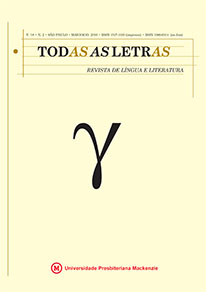O que soa “gay”:
prosódia, interpretação e julgamentos da fala masculina
Resumo
Este artigo descreve um experimento de percepção sociolinguística cujo objetivo é verificar o que especificamente as pessoas ouvem ao avaliarem a sexu-alidade de um falante. Produziram-se digitalmente quatro estímulos, por meio do encurtamento da duração de sibilantes e do estreitamento do intervalo de pitch na fala de um homem lendo um texto. Os ouvintes atribuíram notasa várias combi-nações dos quatro estímulos em dez escalas, entre as quais se incluem “hétero/gay” e “efeminado/masculino”. As modificações das duas variáveis foram insufi-cientes para alterar significativamente as percepções dos ouvintes sobre a sexua-lidade do falante. Contudo, correlações significativas entre as diferentes escalas ilustram o fato de que percepções sobre sexualidade são ideologicamente ligadas a outras percepções sobre personalidade e individualidade.
Downloads
Referências
BELL, A. Language style as audience design. Language in Society, v. 13, n. 2, p. 145-204, June 1984.
BELL, A. Back in style: reworking audience design. In: ECKERT, P.; RICKfORD, J. R. (Ed.). Style and sociolinguistic variation. Cambridge: Cambridge University Press, 2001. p. 139-69.
BUCHOLTz, M.; HALL, K. Theorizing identity in language and sexuality resear-ch. Language in Society, v. 33, n. 4, p. 469-515, Oct. 2004.
CAMERON, D.; KULICK, D. Language and sexuality. London: Cambridge Uni-versity Press, 2003.DERRIDA, J. Limited Inc. Evanston, Ill. Evanston: Northwestern University Press, 1995.
ECKERT, P. Demystifying sexuality and desire. In: CAMPBELL-KIBLER, K. et al. (Ed.). Language and sexuality: contesting meaning in theory and practice. Stan-ford: Center for the Study of Language and Information, 2002. p. 99-110.fRY, D. B. Experiments in the perception of stress. Language and Speech, v. 1, n. 2, p. 126-152, Apr./June 1958.
GAUDIO, R. P. Sounding gay: pitch properties in the speech of gay and straight men. American Speech, v. 69, n. 1, p. 30-57, Spring 1994.
GILES, H.; POWESLAND, P. f. A social psychological model of speech diversity. In: GILES, H.; POWESLAND, P. (Ed.). Speech style and social evaluation. New York: Harcourt Brace, 1975. p. 154-170.
HENTON, C. G. fact and fiction in the description of female and male pitch. Language & Communication, v. 9, n. 4, p. 299-311, 1989.
HENTON, C. G. Pitch dynamism in female and male speech. Language & Com-munication, v. 15, n. 1, p. 43-61, Jan. 1995
IRVINE, J. “Style” as distinctiveness: the culture and ideology of linguistic diffe-rentiation. In: ECKERT, P.; RICKfORD, J. R. Style and sociolinguistic variation. Cambridge: Cambridge University Press, 2001. p. 21-43.
JASSEM, W. On the pitch and compass of the speaking voice. Journal of Phone-tics, v. 1, n. 2, p. 59-68, 1971.
KLATT, D. H. The duration of [S] in English words. Journal of Speech and Hea-ring Research, v. 17, n. 1, p. 51-63, Mar. 1974.
KLATT, D. H. Vowel lengthening is syntactically determined in a connected dis-course. Journal of Phonetics, v. 3, n. 3, p. 129-140, July 1975.
KULICK, D. Gay and lesbian language. Annual Review of Anthropology, v. 29, p. 243-285, Oct. 2000.
LAMBERT, W. E. et al. Evaluational reactions to spoken languages. Journal of Abnormal and Social Psychology, v. 60, p. 44-51, Jan. 1960.
LEHISTE, I. Some factors affecting the duration of syllabic nuclei in English. In: DRACHMAN, G. (Ed.). Akten der 1: Salzburger frühlingstagung für Linguistik, Salzburg vom 24.bis25. Mai 1974. Tübingen: Narr, 1975. p. 81-104.
LEVON, E. Examining a gay prosody: issues in theory, methodology, and iden-tity. Paper presented at Lavender Languages and Linguistics XI, Washington, D.C., 2004.LINVILLE, S. E. Acoustic correlates of perceived versus actual sexual orienta-tion in men’s speech. Folia Phoniatrica et Logopaedica, v. 50, n. 1, p. 35-48, 1998.
NOOTEBOOM, S. The prosody of speech: melody and rhythm. In: HARDCAS-TLE, W. J.; LAVER, J. The handbook of phonetic sciences. Oxford: Blackwell, 1997. p. 640-673.
OLLER, D. K. The effect of position in utterance on speech segment duration in English. Journal of the Acoustical Society of America, v. 54, n. 5, p. 1235-1247, Nov. 1973.
PODESVA, R. “The stylistic use of phonation type: falsetto, fundamental fre-quency, and the linguistic construction of personae.” Unpublished MS. 2003.
PODESVA, R. J.; ROBERTS, S. J.; CAMPBELL-KIBLER, K. Sharing resources and indexing meaning in the production of gay styles. In: CAMPBELL-KIBLER, K. et al. (Ed.). Language and sexuality: contesting meaning in theory and prac-tice. Stanford: Center for the Study of Language and Information, 2002. p. 175-190.
RICH, A. Compulsory heterosexuality and lesbian existence. Signs: Journal of Women in Culture and Society, n. 5, p. 631-660, 1980.
ROGERS, H.; SMYTH, R. Phonetic differences between gay- and straight-soun-ding male speakers of North American English. In: INTERNATIONAL CON-GRESS Of PHONETIC SCIENCES, 15., Barcelona, 2003. Proceedings... Barce-lona: Universitat Autònoma de Barcelona, 2003. p. 1855-1858.
ROGERS, H.; SMYTH, R.; JACOBS, G. Vowel and sibilant duration in gay- and straight-sounding male speech. In: International Gender and Language Asso-ciation Conference, 1., 2000, Stanford. Papers... Stanford, 2000.
SCHERER, K. R. Judging personality from voice: a cross-cultural approach to an old issue in interpersonal perception. Journal of Personality, v. 40, n. 2, p. 191-210, June 1972.
SMYTH, R.; JACOBS, G.; ROGERS, H. Male voices and perceived sexual orien-tation: an experimental and theoretical approach. Language in Society, v. 32, n. 3, p. 329-350, June 2003.
UMEDA, N. Consonant duration in American English. Journal of the Acoustical Society of America, v. 61, n. 3, p. 846-858, Mar. 1977.
VALENTINE, D. “I went to bed with my own kind once”: the erasure of desire in the name of identity. Language & Communication, v. 23, n. 2, p. 123-138, Apr. 2003.
Downloads
Publicado
Como Citar
Edição
Seção
Licença
Copyright (c) 2016 Todas as Letras - Revista de Língua e Literatura

Este trabalho está licenciado sob uma licença Creative Commons Attribution-NonCommercial 4.0 International License.
Os direitos autorais dos artigos publicados na Todas as Letras pertencem aos autores, que concedem à Universidade Presbiteriana Mackenzie os direitos exclusivos de publicação do conteúdo. É vedada sua reprodução total ou parcial sem a devida autorização da Comissão Editorial, exceto para estudo e pesquisa.




